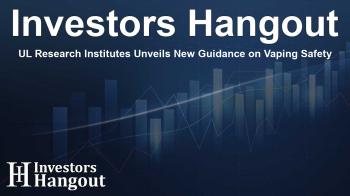UL Research Institutes Unveils New Guidance on Vaping Safety

Understanding the New Guidelines on Electronic Nicotine Delivery Systems
UL Research Institutes' Chemical Insights has recently shared essential guidance about electronic nicotine delivery systems (ENDS). This new resource, known as the 'Science Education and Research on Vaping and Interventions for Community Engagement' (SERVICE), aims to clarify misconceptions surrounding vaping while focusing on safety practices pertinent to users and the community.
Created by Experts
The SERVICE guidance document was meticulously developed by a distinguished task force composed of professionals from various academic and healthcare institutions. This group included representatives from prominent organizations, ensuring a well-rounded perspective on the complexities of vaping. Experts brought in their knowledge from diverse fields, contributing to a resource that serves many stakeholders.
Addressing Misconceptions
One of the critical goals of the SERVICE guidance is to debunk popular myths about vaping. As Christa Wright, Ph.D., co-chair of the task force, stated, "Safer does not mean safe." This sentiment resonates strongly throughout the guidance, as it aims to challenge false beliefs that might lead to increased risks among users and their communities.
Common Myths Dispelled
Here are some of the misconceptions that the guidance effectively addresses:
- ENDS emissions are merely harmless water vapor.
- Vaping is significantly safer than smoking traditional cigarettes.
- Vaping poses no harm to individuals nearby.
- Vaping during pregnancy is safe for both the mother and child.
- Vapes do not contribute to environmental pollution.
- It is acceptable to use vapes along with traditional cigarettes or marijuana.
- Vaping is not an addictive behavior.
Commitment to Public Health
Christopher Cramer, Ph.D., Senior Vice President and Chief Research Officer for ULRI, expressed pride in the Institute's role in this initiative. He emphasized that the guidance is a significant step towards fostering a better understanding of the risks related to vape emissions. The research not only focuses on primary exposure but also highlights the effects of secondary and tertiary exposure, showcasing a commitment to community health.
Short and Long-term Implications
By addressing these misconceptions, the guidance aims to assist individuals and organizations in implementing practical measures to enhance public health. From workplaces to schools, understanding these risks is crucial for creating a safer environment. As vaping continues to rise in popularity, enlightened discussions around its implications are more important than ever.
The Role of Chemical Insights
Chemical Insights operates as a nonprofit organization dedicated to research and education surrounding environmental health. Its mission revolves around providing valuable data and resources tailored to aid manufacturers, educators, and healthcare professionals in making informed decisions regarding health risks associated with emerging technologies.
About UL Research Institutes
UL Research Institutes, established in 1894, is firmly rooted in the pursuit of advancing public safety through scientific endeavors. The organization is committed to conducting rigorous independent research addressing a breadth of global risks, including fire safety, air quality issues, and the emergence of digital privacy challenges. Their overarching goal is to address existing and developing threats to human safety effectively.
Frequently Asked Questions
What is the purpose of the SERVICE guidance document?
The document aims to provide comprehensive insights on electronic nicotine delivery systems and correct misconceptions about vaping safety.
Who are the contributors to this guidance?
It was developed by a task force of experts from various academic and healthcare institutions, ensuring a solid foundation of knowledge.
What myths about vaping does the guidance address?
The guidance tackles common misconceptions, including the belief that vaping is safe and that it doesn't harm those nearby.
Why is it important to debunk these myths?
Addressing these myths helps reduce health risks and promotes informed decision-making among users and the community.
How does UL Research Institutes contribute to public safety?
Through rigorous research and education, UL Research Institutes focuses on identifying risks and providing guidance to advance safety initiatives.
About The Author
Contact Owen Jenkins privately here. Or send an email with ATTN: Owen Jenkins as the subject to contact@investorshangout.com.
About Investors Hangout
Investors Hangout is a leading online stock forum for financial discussion and learning, offering a wide range of free tools and resources. It draws in traders of all levels, who exchange market knowledge, investigate trading tactics, and keep an eye on industry developments in real time. Featuring financial articles, stock message boards, quotes, charts, company profiles, and live news updates. Through cooperative learning and a wealth of informational resources, it helps users from novices creating their first portfolios to experts honing their techniques. Join Investors Hangout today: https://investorshangout.com/
The content of this article is based on factual, publicly available information and does not represent legal, financial, or investment advice. Investors Hangout does not offer financial advice, and the author is not a licensed financial advisor. Consult a qualified advisor before making any financial or investment decisions based on this article. This article should not be considered advice to purchase, sell, or hold any securities or other investments. If any of the material provided here is inaccurate, please contact us for corrections.

